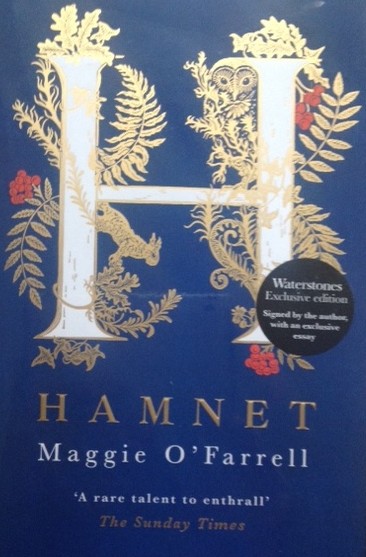Inspiring Older Readers
 posted on 28 Sep 2020
posted on 28 Sep 2020
Hamnet by Maggie O’Farrell
The details of the life of William Shakespeare and his family are so thinly documented that they provide plenty of potential for a novelist to embroider the detail without too much let or hindrance. We do know that Shakespeare and his wife had children and that one of them, Hamnet, died at the age of 11 in 1596 at home in Stratford-Upon-Avon. The cause of his death is unknown. What we do know is that, a handful of years later, Shakespeare wrote his most famous tragedy, Hamlet – a common variant spelling of Hamnet – that had a father/son motif at its heart.
We also know, or at least I thought we knew, that Shakespeare’s wife was called Anne but O’Farrell in a note at the end of the book tells us that her father, Richard Hathaway, referred to her as Agnes in his last will and testament – a name O’Farrell chooses to retain throughout.
In fact, the book is really an extended portrait of Agnes and her imagined life as a 16th century woman, mother, wife, daughter. In her review of the book for The Observer, Stephanie Merritt describes Agnes thus:
“O’Farrell’s Agnes is a woman whose origins merge into a particularly English kind of folklore – “There used to be a story in these parts about a girl who lived at the edge of a forest” – harking back to a deep connection between humans and landscape, with echoes of tales such as Sir Gawain and the Green Knight.”
Shakespeare himself remains a deliberately transparent figure, more absent than not and never actually named. He is referred to as ‘the Latin tutor’ and is shown pining to get away from Stratford and the constraints of his domestic life in pursuit of the life of the playhouse and the glitz of London. He dreams of bringing Agnes to London too but she is too rooted in the landscape of her home and tearing her from Stratford would be like uprooting a tree. He’s an absent father who has to deal with the guilt of being absent when his son dies – a trauma, O’Farrell suggests, he deals with in the only way he knows how through dramatic creation.
At a time when Covid 19 is our 21st century plague, O’Farrell introduces its 16th and 17th century counterpart, bubonic plague, as the dark spectre stalking the Shakespearean landscape. Hamnet was one of twins with his sister Judith and it is the girl who first contracts the disease and is expected to die. Ultimately though O’Farrell allows the girl to survive and it is Hamnet who succumbs – a dramatic invention by the author given that the cause of Hamnet’s actual death is unknown.
The recovery of one child and the unexpected death of another constitutes the dramatic tension in the novel and around that O’Farrell tells Agnes’s story by cutting between flashback and contemporaneous action. There is some striking and exquisite writing that makes up the vignettes and set-pieces and by contrast with how gossamer-thin the character of Shakespeare is here, Agnes fills out the pages as a fully imagined three dimensional character.
Perhaps the most striking passage in the book is the dozen or so pages O’Farrell takes to describe the way the plague virus travels right across Europe to eventually find its way via fleas to the British coast and then to Stratford and on to young Judith. I found myself reading this section as if it were a forensic drama being played out in front of my eyes with all the inevitability of a Greek tragedy.
Joanna Briscoe’s review of the novel for The Guardian wraps up her piece with a conclusion I’m more than happy to stand for my views too – and more effectively expressed than I could have managed:
“As with much contemporary retelling of Greek mythology from a woman’s perspective, this is an almost entirely female take on a familiar story, done with a characteristic lightness of touch and accessibility that achieves universality. At her best, O’Farrell is simply outstanding. Within pages, she can inhabit the mind of an owl, of a great playwright, of a dying boy, of those watching him. It seems she can pretty much do anything on the page that she puts her mind to. Immersive, at times shockingly intimate, and triumphantly brought to fruition, this is a work that ought to win prizes.”
At the time of writing this review, it’s still only available as a new hardback but I’m sure the paperback edition will be along very shortly.
Terry Potter
September 2020